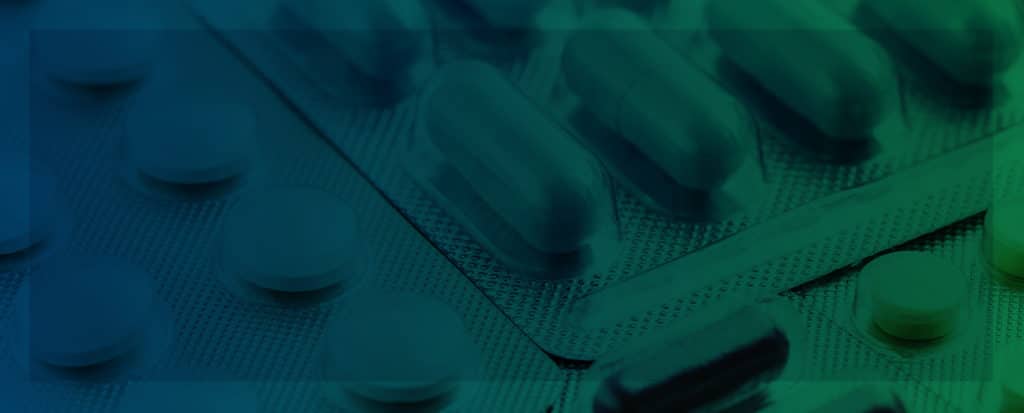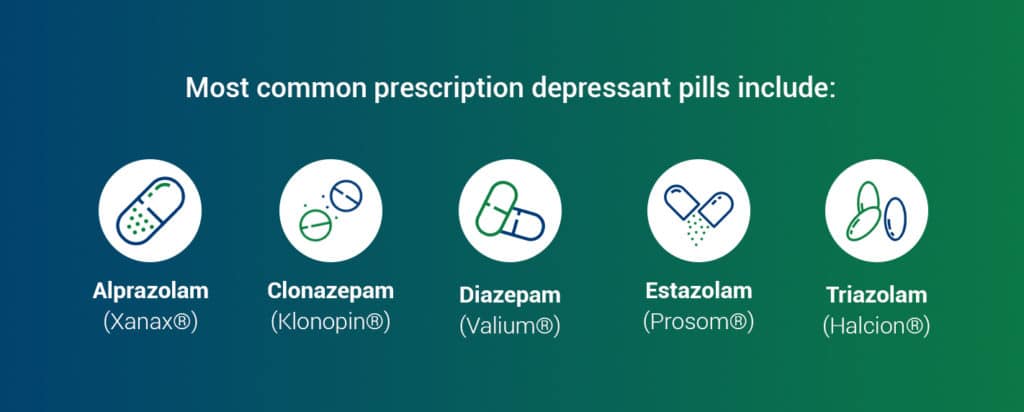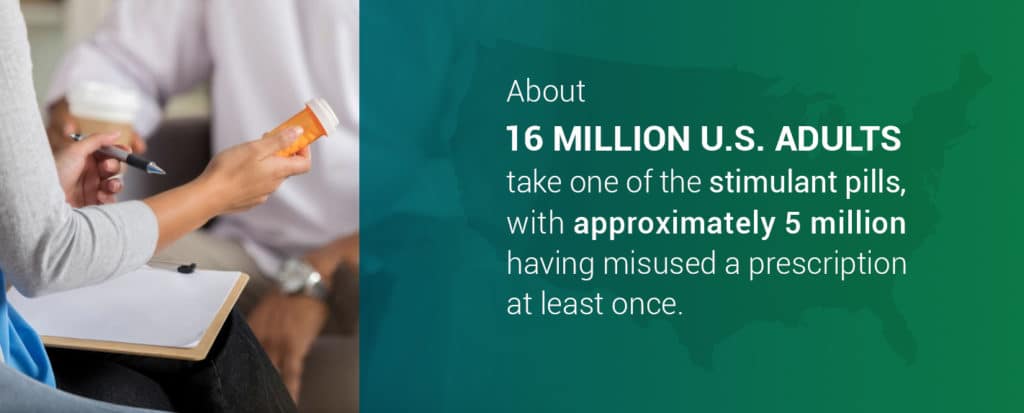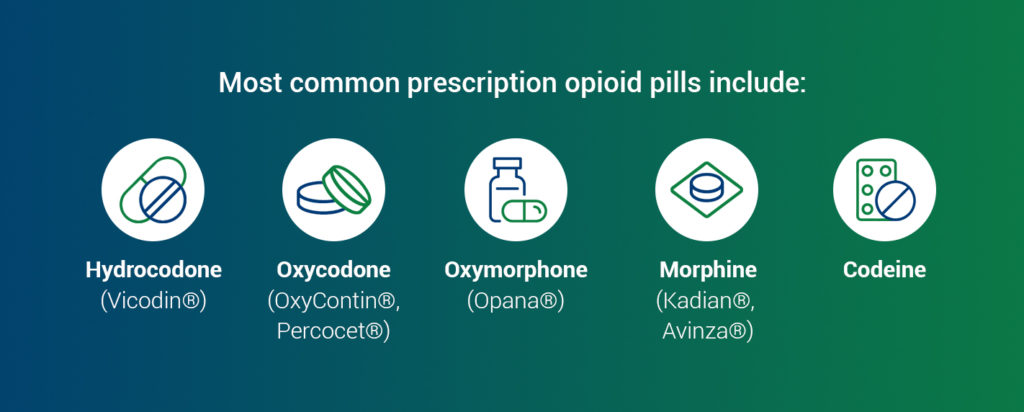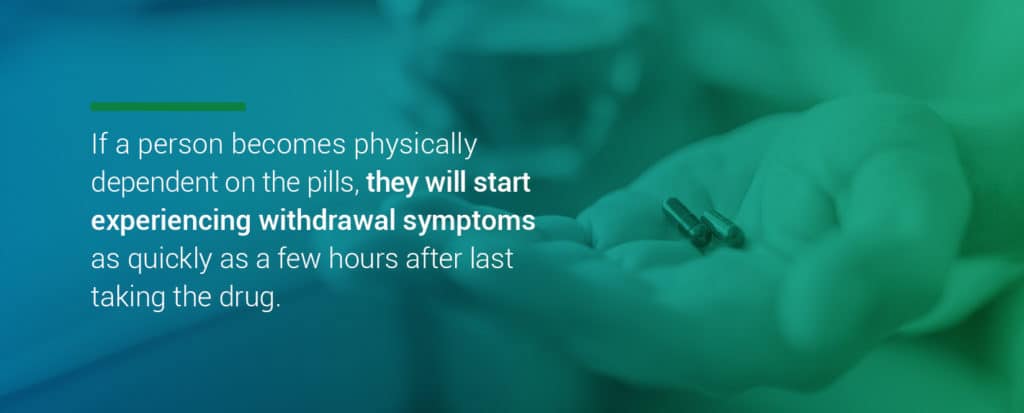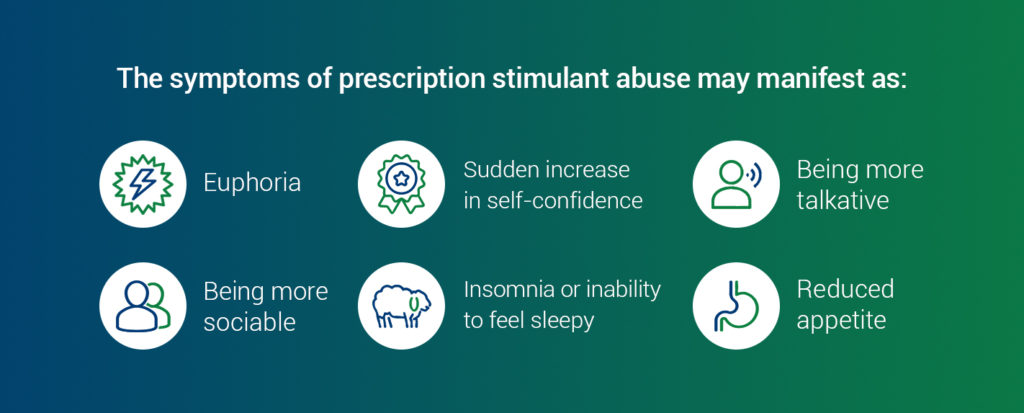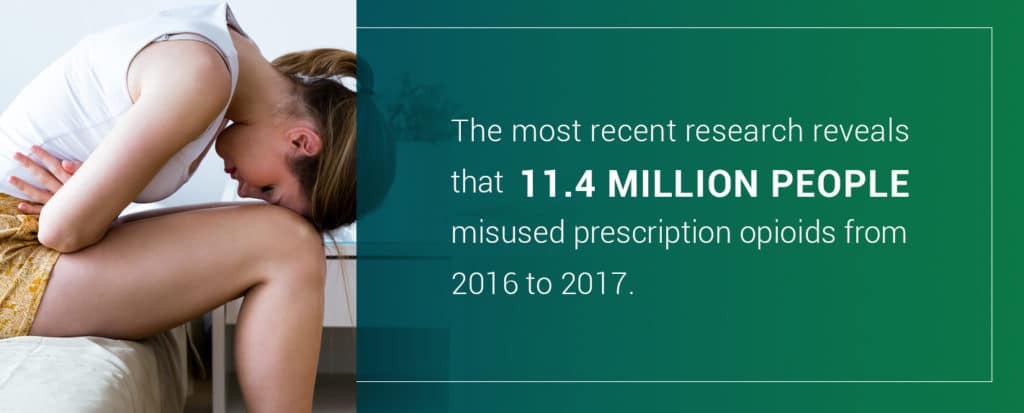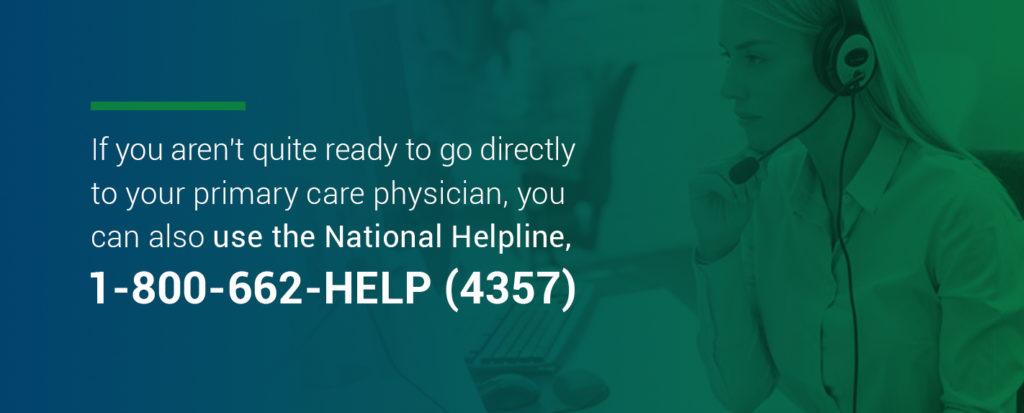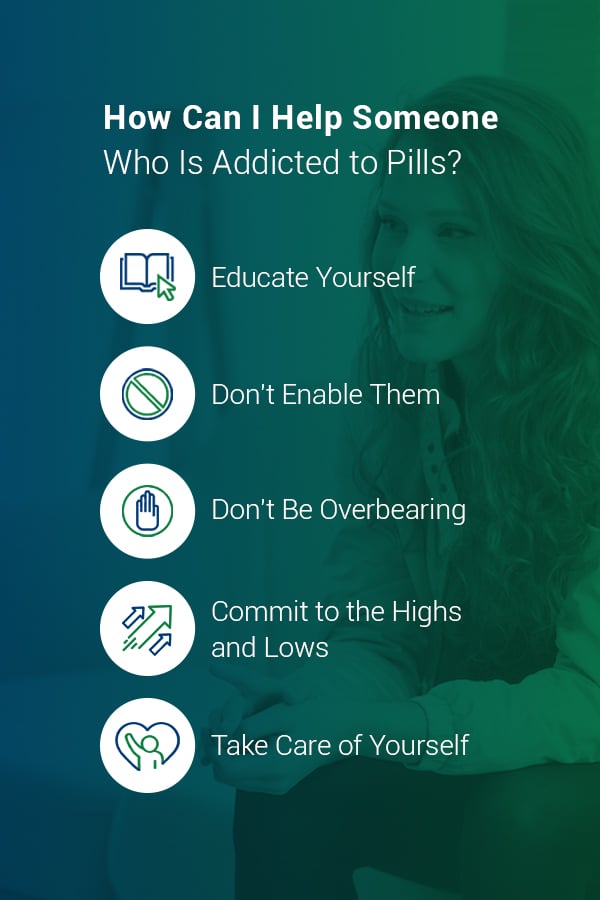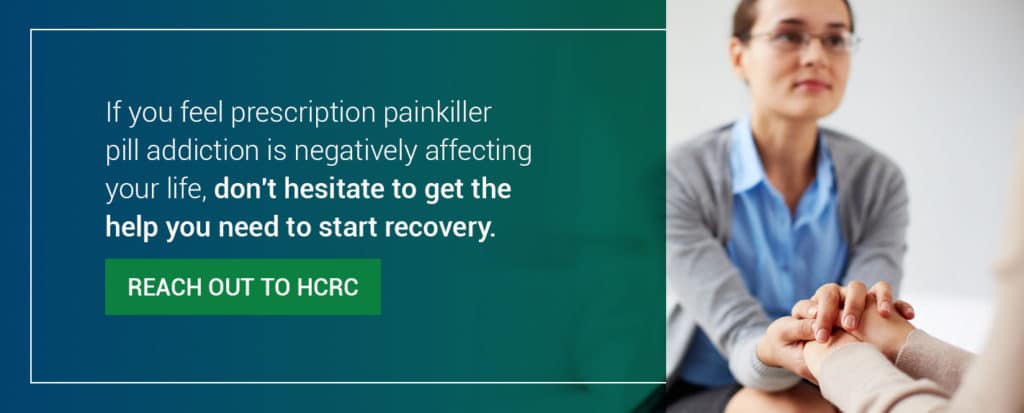Physicians prescribe pills for a wide variety of reasons. There are medications to lower blood pressure, relieve pain, control symptoms of diseases, and much more. However, not all pills are safe to take over the long term — even when prescribed by a doctor. Pill abuse and addiction are real issues and can be frightening when you or someone you care about starts showing signs of dependence on a prescribed medication.
Learning more about how different types of pills work and what pill addiction looks like is the first step in getting the appropriate treatment for anyone struggling with prescription drug abuse.
Common Types of Prescription Pills Abused
Three categories of prescription pills have a strong potential for abuse: opioids, depressants, and stimulants. Each class of drugs has unique properties that make them suitable for treating certain conditions, but they also prompt reactions in the brain that can lead quickly to addiction.
Common Prescription Depressant Pills
Central nervous system (CNS) depressants are a group of medications that slow down the brain’s activity. Health care professionals prescribe them to treat panic, anxiety, and sleep disorders and help people deal with acute stress reactions. CNS depressants include drugs that fall into the tranquilizer, sedative, and hypnotic categories. Benzodiazepines are some of the most common CNS depressants, including:
-
-
- Alprazolam (Xanax®)
- Clonazepam (Klonopin®)
- Diazepam (Valium®)
- Estazolam (Prosom®)
- Triazolam (Halcion®)
-
Primary care physicians are increasingly prescribing benzodiazepines, also known as “benzos.” The percentage of outpatient medical appointments in which a provider wrote a benzodiazepine prescription doubled between 2003 and 2015, and about half of the prescriptions came from primary care physicians.
Other CNS depressants include the sedative hypnotics zolpidem (Ambien®), eszopiclone (Lunesta®) and zaleplon (Sonata®), which are sleep aids. Barbiturates, which doctors prescribed extensively during the 1960s and 1970s, are also under the depressant umbrella. These drugs have names ending in “-ital,” like phenobarbital, which controls seizures and relieves anxiety.
Common Prescription Stimulant Pills
Stimulants are a broad group of drugs, including any that raise activity in the nervous system. They amplify alertness and can give users a rush of energy, leading to their nickname, “uppers.” Health professionals usually prescribe stimulants to treat narcolepsy or ADHD. The most common prescription stimulants are:
-
-
- Dextroamphetamine (Dexedrine®)
- Dextroamphetamine/amphetamine combination product (Adderall®)
- Methylphenidate (Ritalin®, Concerta®)
-
Stimulant prescriptions are quite common in the United States. About 16 million U.S. adults take one of these medications, with approximately 5 million having misused a prescription at least once. More than 56 percent of those who misuse stimulants report doing so because they wanted the benefits of the drugs’ cognitive enhancement. People in stressful school and work environments often abuse prescription stimulants to increase their productivity without realizing the drugs can be addictive.
Common Prescription Opioid Pills
Opioids are a class of drugs derived from the poppy plant or synthesized to resemble similar compounds. Opioids help treat pain. The active chemicals in these painkillers bond with receptors in the brain and throughout the body, causing changes in how the brain perceives pain. They are effective medications when taken as directed, but they are also so powerful they can easily cause physical and mental dependence. Here are some of the most commonly prescribed opioids:
-
-
- Hydrocodone (Vicodin®)
- Oxycodone (OxyContin®, Percocet®)
- Oxymorphone (Opana®)
- Morphine (Kadian®, Avinza®)
- Codeine
-
These drugs, particularly those formulated with oxycodone and hydrocodone, are vastly overprescribed in the United States and have been for years. In 2017, these disturbing statistics took the spotlight:
-
-
- There were nearly 58 opioid prescriptions for every 100 Americans.
- More than 17 percent of Americans had one or more prescriptions filled.
- On average, people filled more than three prescriptions per patient.
-
Between 21 and 29 percent of people prescribed opioids for chronic pain end up misusing them. Somewhere between 8 and 12 percent go on to develop an opioid use disorder. More than 130 people die from opioid overdoses every day.
Signs of Prescription Pill Addiction
Identifying abuse and addiction with prescription medications is more complicated than with illicit drugs. Doctors may instruct people to take some prescriptions, like the anti-anxiety depressant Xanax, at the onset of an acute anxiety episode. However, most users need to take prescription pills consistently to maintain their therapeutic effects. Someone taking oxycodone, for example, may need to take the medication every 4 to 12 hours, depending on its formula.
Many people do not see anything wrong with taking an extra pill every now and then, but any use of prescription medication outside of the prescription guidelines constitutes misuse. When someone becomes addicted to pills, they will start to display heightened side effects of the medication, which may become apparent to those close to them. The possible side effects vary among classes of drug.
Signs of Prescription Anti-Anxiety Abuse
The most common anti-anxiety pills are central nervous system depressants. By increasing the activity of a chemical called gamma-aminobutyric acid, these medications reduce activity in the brain. This phenomenon leads to a calmer, more drowsy state. While these results make CNS depressants a good option for treating anxiety and sleep disorders, taking them without a prescription or in larger quantities than prescribed leads to these side effects:
-
-
- Slurred speech
- Confusion
- Inability to concentrate
- Headaches and lightheadedness
- Dizziness
- Motor skill impairment
- Dry mouth
- Low blood pressure
- Slowed breathing
-
A person abusing depressants will appear uncoordinated and confused. They may display greatly diminished awareness of their surroundings and have trouble answering simple questions. If the person becomes physically dependent on the pills, they will start experiencing withdrawal symptoms as quickly as a few hours after last taking the drug. Because this class of medication interacts directly with the nervous system, withdrawal symptoms are severe and potentially life-threatening. They include:
-
-
- Severe cravings
- Hallucinations
- Increased heart rate and blood pressure
- Fever
- Sweating
- Agitation and paranoia
- Insomnia
- Trembling or shaking
- Seizures
-
Anyone abusing benzodiazepines and other anti-anxiety medications needs medical supervision as they start eliminating the drugs from their system to ensure a safe start to recovery.
Signs of Prescription Stimulant Abuse
Stimulant abuse results in the opposite effects of depressants. Someone abusing prescription stimulants will appear unusually bright-eyed and energetic. Their symptoms may manifest as:
-
-
- Euphoria
- Sudden increase in self-confidence
- Being more talkative
- Being more sociable
- Insomnia or inability to feel sleepy
- Reduced appetite
-
Someone abusing stimulants will go from feeling on top of the world after they take the medication to feeling awful and irritable as the drug leaves their system. Stimulant abuse also has acute short-term physical effects that get worse the more they take, including:
-
-
- Increased blood pressure and heart rate
- Increased respiration
- Decreased circulation
- Increased blood sugar
- Irregular heartbeat or palpitations
- Nausea and vomiting
- Gastrointestinal distress
- Stroke
- Seizures
-
Although the threat of overdose from prescription stimulants is very real, withdrawal symptoms are somewhat less severe than with other medication categories. The most prevalent stimulant withdrawal symptoms are irritability, aches and pains, depressed mood and reduced social function.
Signs of Prescription Opioid Abuse
Painkiller pill addiction is driving what may be the worst addiction epidemic in the world. The most recent research reveals that 11.4 million people misused prescription opioids from 2016 to 2017, and 2.1 million people met the criteria for an opioid use disorder.
Chronic pain is a severe issue that affects millions of Americans, and painkillers are an effective way to treat pain in the short term. However, the longer someone takes opioids, the more likely it is they will become addicted. These rapidly worsening side effects can be signs that someone is taking more than their prescription specifies:
-
-
- Constipation
- Nausea
- Confusion
- Hallucinations
- Sweating
- Dry mouth
- Sedation
-
These side effects can accompany legitimate opioid use, but if they are suddenly more intense or apparent than usual, it can be because the individual has begun using the medication outside their prescription guidelines. Withdrawal from opioids is intense and can easily stop someone from moving forward with detoxification and recovery. Once the body has become physically dependent on opioids, a person accustomed to their use will start experiencing these symptoms within hours after last taking the medication:
-
-
- Agitation and irritability
- Excess tearing
- Aching and cramping muscles
- Insomnia
- Sweating
- Runny nose
- Yawning
-
These are just the earliest symptoms. The most painful and challenging part of withdrawal comes two to four days later and brings:
-
-
- Abdominal cramping
- Nausea
- Diarrhea
- Vomiting
- Goosebumps
-
Opioid withdrawals are the most significant pain pill addiction signs and can stop even the most motivated person in their tracks when it comes to recovery. Getting the appropriate treatment is the most effective way to reduce or entirely avoid the worst symptoms and complete the elimination of opioids from the body.
When and How to Seek Treatment for Pill Addiction
If you are doing anything other than taking your pills exactly as prescribed, it is imperative to seek the advice of a medical professional. Addiction can start with seemingly small actions, like skipping a dose of medication so you can take double the amount the next time. These small behaviors add up and reinforce the brain’s dependence on your medication, significantly increasing the chances of developing an addiction.
The first thing to do is to talk to your doctor about your concern. It can be frightening to lay all your worries out on the table, but your doctor is there to help you, and they cannot do that without having all the facts in hand. Your doctor will ask some questions about your drug abuse and possibly have you take a drug test. Depending on your answers and results, they may be able to provide a diagnosis on the spot or may refer you to a mental health specialist for diagnosis.
Either way, the diagnosing professional will use the criteria for substance use disorders (SUD) from the Diagnostic and Statistical Manual of Mental Health Disorders, Fifth Edition, to provide your diagnosis. These diagnostic criteria apply to all drugs of abuse, including prescription pills:
-
-
- Hazardous use that is dangerous to yourself or others
- Use which causes issues or conflicts in relationships
- Use that causes you to neglect responsibilities of major roles at work, school or in the home
- Withdrawal symptoms when you stop using the substance
- Tolerance that causes you to use more of the substance to get the same effect
- Use of larger amounts of the drug over a longer period
- Repeated attempts to reduce or stop using the substance
- Significant amounts of time spent using or acquiring the substance
- Physical or mental health issues relating to use of the substance
- Cessation of normal activities in favor of substance use
- Craving for the substance
-
To receive an SUD diagnosis, you must have met two or more of these criteria within the past year. Meeting two to three of the requirements constitutes a mild SUD. Four to five criteria indicate a moderate SUD. People with severe SUDs meet six or more in the past 12 months.
If you are not quite ready to go directly to your primary care physician, you can also use the National Helpline provided by the Substance Abuse and Mental Health Services Administration. The number for the Treatment Referral Routing Service is 1-800-662-HELP (4357), and they can provide free, confidential information to get you started 24/7.
How Can I Help Someone Who Is Addicted to Pills?
Once you have seen the warning signs and pain pill addiction symptoms, you cannot ignore pill addiction in a loved one. You may be hurt and confused by their actions and behavior, but you know it is essential for you to provide support. The question is: How? Here are five tips to help you help someone you care about.
1. Educate Yourself
We have given you brief overviews of different types of pills and how they affect the people who take them, but there is no substitute for doing in-depth research on the drug your loved one is abusing. Learning more about addiction and the different properties of specific drugs can help you gain a clearer understanding of the changes driving your loved one’s altered behavior.
2. Do Not Enable Them
Often, it can feel like the only way to keep an addicted individual in your life at all is to enable their drug use. Do not do it. Do not lend them a few bucks to get their next stimulant fix or cover for them missing yet another get-together because they feel groggy from taking too many painkillers. These can seem like harmless actions that keep things from blowing up, but all they do is reinforce the drug use and drug-seeking behavior in the person you care about.
Disengaging from enablement is easier said than done. People struggling with addiction are walking a fine line already and letting them know you will not be doing certain things anymore can cause great upset. The best thing you can do is remain as calm as possible and remind them you are here to support them even if you are changing the ways in which you interact. Be clear that you will help them get treatment when they are ready.
3. Do Not Be Overbearing
No one likes people to lecture or talk down to them, especially while wrestling with an issue as significant as addiction. While your research on addiction and treatment can be invaluable, you have to be careful about the way you present the information. It is likely the addicted individual has done at least some investigation on their own, so launching into a comprehensive educational speech is not likely to impress them.
Whenever possible, share information in a collaborative format, rather than in a manner that feels like you are telling the person what to do.
4. Commit to the Highs and Lows
Recovery is not a linear progression. There will be setbacks, obstacles, and times of high emotional tension as your loved one tries to regain their recovery. As a friend or family member, you do not have access to all the internal changes the person is dealing with, and their behavior may seem completely confounding at times. Accepting that there will be ups and downs is crucial to providing strong support.
That does not mean you need to strap into the roller coaster and experience each twist and turn yourself. It just means you have to be realistic about your expectations.
5. Take Care of Yourself
Supporting someone through recovery from prescription pill addiction can be emotionally draining. If you are not careful, you may end up giving too much of yourself and neglecting your needs. One essential action is to set clear boundaries. Ask yourself: How much communication am I willing to do? When do I need to be unavailable? How do I know when the emotional toll is becoming too much?
Enlisting professional help from a counselor or therapist is a good idea for people who are trying to help a loved one achieve or keep recovery. They can provide you with strategies and scripts to use to make sure your boundaries are appropriate for maintaining your mental health through the process of helping with a pain pill addiction.
Common Questions About Pill Addiction Answered
Prescription drug addiction is a complex topic, and there are a lot of questions about many aspects of the issue. Here are some of the most frequently asked questions about prescription pill addiction.
Q: Where do people get the prescription pills they abuse?
A: The majority of people who abuse pills start with a legitimate prescription from their doctor. Once their tolerance grows and addiction sets in, they may buy more pills off the street or attempt to shop around for new doctors who will write them more prescriptions.
Q: Is mixing prescription pills dangerous?
A: Yes. The majority of fatal overdoses result from the use of multiple drugs, such as mixing benzodiazepines with opioids.
Q: Can I avoid the side effects and risks of opioid use?
A: No. Even legitimate prescription opioid use is a risk to any patient. Anyone can experience side effects, and anyone can get addicted.
Q: Are some prescription pills safer than others?
A: While opioid painkillers cause the most deaths, all three of the drug classes mentioned here have certain aspects that make them uniquely dangerous in terms of the potential for overdose or addiction. There are no “better” or “worse” options when it comes to drug abuse.
Q: What increases the risk of prescription pill addiction?
A: Generally speaking, your risk of addiction increases the longer you take a medication. Underlying factors such as depression or mental illness and genetic predispositions may also increase your propensity toward addiction.
Q: What is the treatment for prescription pill addiction?
A: Most treatment programs employ a combination of therapy and medication to help individuals learn recovery strategies while eliminating the substance from their bodies. Ongoing therapy and group support are usually necessary to maintain recovery in the long run.
Take the Next Step with Health Care Resource Centers
Whether it has developed in you or in a person you care about, prescription drug abuse and addiction are daunting issues to tackle. Health Care Resource Centers (HCRC) is a group of clinics dedicated to helping those with prescription opioid addiction get back the life they deserve. Our programs are federally-certified, state-licensed, and accredited by the Commission on Accreditation of Rehabilitation Facilities (CARF). We provide evidence-based treatment that helps maximize each individual’s chance at sustained recovery.
For opioid addiction, HCRC provides both methadone and buprenorphine maintenance programs. These are part of a treatment type known as medication-assisted treatment (MAT). These programs use either methadone or buprenorphine to stop the symptoms of withdrawal before they can even begin, allowing people to feel normal enough to pursue recovery.
You and your loved ones do not have to struggle with addiction alone. If you feel prescription painkiller addiction is negatively affecting your life, do not hesitate to get the help you need to start recovery. Reach out to HCRC to take the first steps on your journey to freedom from prescription pills. Call us at 866-758-7769 to speak to one of our knowledgeable representatives, or visit our locations page to find the clinic nearest you.

